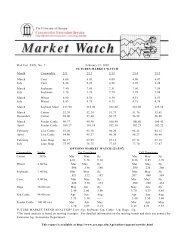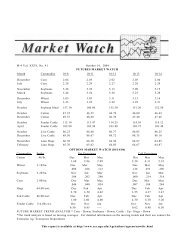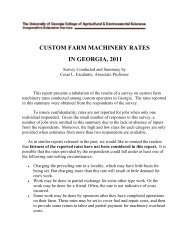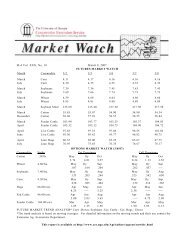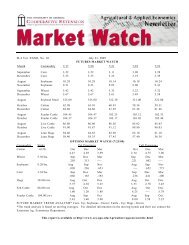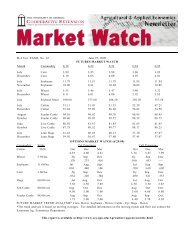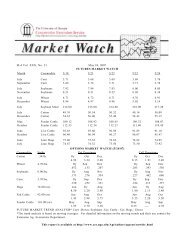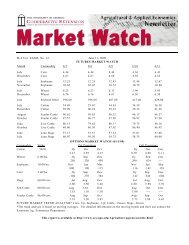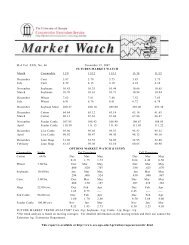GEORGIA SMALL FARM RECORD BOOK - University of Georgia
GEORGIA SMALL FARM RECORD BOOK - University of Georgia
GEORGIA SMALL FARM RECORD BOOK - University of Georgia
Create successful ePaper yourself
Turn your PDF publications into a flip-book with our unique Google optimized e-Paper software.
<strong>GEORGIA</strong><br />
<strong>SMALL</strong> <strong>FARM</strong><br />
<strong>RECORD</strong> <strong>BOOK</strong><br />
Year_________<br />
Cooperative Extension Service/The <strong>University</strong> <strong>of</strong> <strong>Georgia</strong><br />
College <strong>of</strong> Agricultural and Environmental Sciences/Athens
TABLE OF CONTENTS<br />
Instructions for Easy Record Keeping 1<br />
Cash Farm Income 4<br />
Cash Farm Expenses 7<br />
Summary <strong>of</strong> Farm Income and Expenses 15<br />
Changes To Be Made 15<br />
Crop Summary 16<br />
Livestock Summary 17<br />
Feed and Supply Summary 17<br />
Net Worth Statement 18
<strong>Georgia</strong> Farm Record Book<br />
for<br />
Small And Part-Time Farmers<br />
This record book has been prepared for use by small and part-time farm operators in<br />
<strong>Georgia</strong>. It is intended to provide access to cash income, cash expenses and other information<br />
needed to make pr<strong>of</strong>itable farm management decisions.<br />
This book is not designed for a complete farm business analysis, but rather to help<br />
document only cash income and cash expenses. If a complete farm business analysis is needed,<br />
Depreciation, Capital Inventories, etc., then the <strong>Georgia</strong> Farm Record Book should be used. For a<br />
copy <strong>of</strong> this Book, contact your local County Extension Office.<br />
INSTRUCTIONS FOR EASY <strong>RECORD</strong> KEEPING<br />
Cash Farm Income<br />
Always record the date <strong>of</strong> the cash farm income as you may need to refer to that date at<br />
some later time. It is very important to remember to record 1) WHAT was sold, 2) the<br />
AMOUNT SOLD and 3) the TOTAL AMOUNT <strong>of</strong> sale in dollars. For example, a 450 pound<br />
calf is sold to John Doe on October 18 for 85 cents per pound. First enter the date (October 18),<br />
next enter the item sold (the calf), enter the amount sold and the selling price (450 pounds@$.85)<br />
or (450 pounds for $382.50) and then enter the total amount <strong>of</strong> the sale ($382.50). Keep up with<br />
useful and practical information!<br />
Cash Farm Expenses<br />
The same procedure should be followed as with cash farm income. Always remember to record 1)<br />
WHAT was bought, 2) the AMOUNT BOUGHT and 3) the TOTAL AMOUNT spent.<br />
For example, five tons <strong>of</strong> 10-10-10 fertilizer is bought on March 17 from Country Pride Farm<br />
Supply for $850.00. First, enter the date (March 17), next enter the item bought (10-10-10<br />
fertilizer), remember to enter the next amount bought and the price paid (5 tons for $850) or (5<br />
tons @$170 per ton) and then enter the total amount <strong>of</strong> the expense item ($850). Again, it is more<br />
important to record what was bought, the amount bought and the price paid than to record from<br />
whom it was bought!<br />
1
Crop Summary<br />
The crop production summary form allows the user to record basic crop production information.<br />
It is important to record acres, yield per acre and total yield by crop or field. This information will<br />
be helpful in making year-end decisions and plans for the future. It will also provide a fertility<br />
history for the crop and farm. Also, this form allows information to be entered by crop but can be<br />
altered slightly to allow for entry by field. Simply strike out enterprises not produced and enter<br />
individual field production.<br />
Livestock Summary<br />
The livestock summary allows the user an opportunity to maintain an accurate accounting <strong>of</strong> the<br />
number <strong>of</strong> livestock on the farm. The user should indicate what kind <strong>of</strong> livestock is present on the<br />
farm in the column listed as Kind. If, for example, on January 1 the operator had 20 beef cows, 1<br />
bull, 4 heifers, and 10 calves, this information could be entered as follows: under Kind list beef<br />
cows and under Number Jan 1 enter 20; then list under Kind the bull and under Number Jan 1<br />
enter 1 and the same procedure for each type or class <strong>of</strong> livestock on the farm.<br />
This information will be <strong>of</strong> help in determining numbers <strong>of</strong> livestock on the farm and in making<br />
decisions concerning the future <strong>of</strong> livestock enterprises. The four columns on the right side <strong>of</strong> this<br />
form are used to record livestock bought, born, sold, died or for home use.<br />
Summary <strong>of</strong> Farm Record<br />
The summary section allows the operator an opportunity to pull together cash farm income and<br />
cash farm expenses to determine net cash income. The bottom <strong>of</strong> the form provides space to write<br />
suggested or planned changes for the coming year.<br />
Net Worth Statement<br />
The net worth statement is a very good indicator <strong>of</strong> the success <strong>of</strong> the farm business. The net<br />
worth statement lists all <strong>of</strong> the assets (things that are owned) and liabilities (things that are owed).<br />
The difference between the value <strong>of</strong> the assets and the liabilities is the net worth or equity. An<br />
increasing net worth indicates the farm business is doing good. A decreasing net worth indicates<br />
some problems in the business that need attention. The net worth statement is also<br />
very helpful when working with lenders to borrow money.<br />
2
Date<br />
CASH <strong>FARM</strong> INCOME<br />
Item Sold<br />
Amount Sold<br />
Total Amount<br />
in Dollars<br />
Sub-Total<br />
XXXX<br />
XXXX<br />
page 3
CASH <strong>FARM</strong> INCOME<br />
Date<br />
Item Sold<br />
Amount Sold<br />
Total Amount<br />
in Dollars<br />
Sub-Total<br />
XXXX<br />
XXXX<br />
page 4
CASH <strong>FARM</strong> INCOME<br />
Date<br />
Item Sold<br />
Amount Sold<br />
Total Amount<br />
in Dollars<br />
Sub-Total<br />
XXXX<br />
Total Cash Farm Income from pages 3-5<br />
page 5<br />
XXXX
CASH <strong>FARM</strong> EXPENSES<br />
Date<br />
Item Bought<br />
Amount Bought<br />
Total Amount<br />
in Dollars<br />
Sub-Total<br />
XXXX<br />
XXXX<br />
page 6
Date<br />
CASH <strong>FARM</strong> EXPENSES<br />
Item Bought<br />
Amount Bought<br />
Total Amount<br />
in Dollars<br />
Sub-Total<br />
XXXX<br />
XXXX<br />
page 7
Date<br />
CASH <strong>FARM</strong> EXPENSES<br />
Item Bought<br />
Amount Bought<br />
Total Amount<br />
in Dollars<br />
Sub-Total<br />
XXXX<br />
XXXX<br />
page 8
Date<br />
CASH <strong>FARM</strong> EXPENSES<br />
Item Bought<br />
Amount Bought<br />
Total Amount<br />
in Dollars<br />
Sub-Total<br />
XXXX<br />
XXXX<br />
page 9
Date<br />
CASH <strong>FARM</strong> EXPENSES<br />
Item Bought<br />
Amount Bought<br />
Total Amount<br />
in Dollars<br />
Sub-Total<br />
XXXX<br />
XXXX<br />
page 10
Date<br />
CASH <strong>FARM</strong> EXPENSES<br />
Item Bought<br />
Amount Bought<br />
Total Amount<br />
in Dollars<br />
Sub-Total<br />
XXXX<br />
XXXX<br />
page 11
Date<br />
CASH <strong>FARM</strong> EXPENSES<br />
Item Bought<br />
Amount Bought<br />
Total Amount<br />
in Dollars<br />
Sub-Total<br />
XXXX<br />
XXXX<br />
page 12
Date<br />
CASH <strong>FARM</strong> EXPENSES<br />
Item Bought<br />
Amount Bought<br />
Total Amount<br />
in Dollars<br />
Sub-Total<br />
XXXX<br />
XXXX<br />
Total Cash Farm Expenses: Add Sub-Totals from pages 6-13<br />
page 13
SUMMARY OF <strong>FARM</strong> INCOME AND EXPENSES<br />
l. TOTAL CASH INCOME (FROM PAGE 5)<br />
$<br />
ll. TOTAL CASH EXPENSES (FROM PAGE 13)<br />
$<br />
lll. NET CASH INCOME (SUBTRACT EXPENSES<br />
FROM INCOME LINE l<br />
MINUS LINE ll)<br />
$<br />
CHANGES TO BE MADE FOR NEXT YEAR:
CROP SUMMARY<br />
Yield Per<br />
Total<br />
Lime Applied<br />
Fertilizer<br />
Field Crops<br />
Acres<br />
Acre<br />
Yield<br />
Per Acre<br />
Analysis<br />
Amount/ Acre<br />
Cotton<br />
Peanuts<br />
Tobacco<br />
Corn<br />
Soybeans<br />
Vegetable Crops<br />
Squash<br />
Tomatoes<br />
Pepper<br />
Beans<br />
Corn<br />
Collards<br />
Cabbage
LIVESTOCK SUMMARY<br />
Number<br />
Number<br />
Number<br />
Number<br />
Number<br />
Number<br />
Kind<br />
Jan. 1<br />
Dec. 31<br />
Bought<br />
Born<br />
Died<br />
for Home Use<br />
FEED AND SUPPLY SUMMARY<br />
Kind<br />
Amount January 1<br />
Amount December 31<br />
page16
ASSETS (What is owned)<br />
Land<br />
Livestock<br />
Machinery<br />
Feed and Supplies<br />
Farm Buildings<br />
Dwelling<br />
Household Equipment<br />
Money Owed to You<br />
Cash Value <strong>of</strong> Life Insurance<br />
Other Property and Savings<br />
TOTAL ASSETS<br />
NET WORTH STATEMENT<br />
Beginning ($)<br />
$<br />
$<br />
Ending ($)<br />
LIABILITIES (What is owed)<br />
Farm Mortgages<br />
Notes You Owe<br />
Accounts Payable<br />
Interested Owed<br />
Land Taxes<br />
Insurance Premiums Due<br />
TOTAL LIABILITIES<br />
$<br />
$<br />
NET WORTH<br />
$<br />
(Assets minus Liabilities)<br />
- $<br />
ASSETS<br />
LIABILITIES<br />
=<br />
$<br />
NET WORTH<br />
Note:<br />
To calculate Net Worth, add beginning and ending Assets and divide by two for<br />
average asset value. Do the same for Liabilities. Then subtract average Liabilities<br />
from average Asset value to determine Net Worth.
NOTES AND COMMENTS
Prepared by: Ronald Atkinson<br />
Extension Farm Management Specialist (Retired)<br />
Revised by Departmental Staff<br />
The Cooperative Extension Service, <strong>University</strong> <strong>of</strong> <strong>Georgia</strong> College <strong>of</strong> Agricultural and<br />
Environmental Sciences <strong>of</strong>fers educational programs, assistance and materials to all<br />
people without regard to race, color or national origin.<br />
AN EQUAL OPPORTUNITY EMPLOYER<br />
Extension Agricultural Economics 8<br />
Miscellaneous Publication No. MP-393 Revised June, 1998<br />
Issued in furtherance <strong>of</strong> Cooperative Extension work, Acts <strong>of</strong> May 8 and June 30, 1914,<br />
The <strong>University</strong> <strong>of</strong> <strong>Georgia</strong> College <strong>of</strong> Agricultural and Environmental Sciences and the<br />
U.S. Department <strong>of</strong> Agriculture cooperating.<br />
Robert Isaac, Associate Director for Extension



